Field Evaluation of the Dust Impacts from Construction Sites on Surrounding Areas: A City Case Study in China
Abstract
1. Introduction
2. Literature Review
2.1. Evaluation Indicators and Emission Characteristics of Building Construction Dust
2.2. Main Influencing Factors of Building Construction Dust
3. Methods
3.1. Monitoring Indicators
3.2. Monitoring Methods
3.2.1. Dust Concentration Monitoring
3.2.2. Meteorological Data Monitoring
3.2.3. Construction Activity Data Collection
3.3. Selection of the Monitoring Samples
4. Results and Discussion
4.1. Analysis of Overall Situation
4.2. Analysis of Up-Downwind Direction Concentration
4.3. Analysis of Up-Downwind Direction Incremental Concentration
4.4. Particle Size Distribution in Building Construction Dust
4.5. Analyzing the Main Influencing Factors of Building Construction Dust
4.5.1. Correlation Analysis of Building Construction Dust and Basic Ambient Air Quality
4.5.2. Correlation Analysis of Building Construction Dust and Meteorological Factors
4.5.3. Correlation Analysis of Building Construction Dust and Construction Intensity
5. Conclusions
Author Contributions
Funding
Acknowledgments
Conflicts of Interest
References
- Ren, L.H.; Zhou, Z.E.; Zhao, X.Y.; Yang, W.; Yin, B.H.; Bai, Z.W.; Ji, Y.Q. Source apportionment of PM10 and PM2.5 in urban areas of Chongqing. Res. Environ. Sci. 2014, 27, 1387–1394. [Google Scholar]
- Song, N.; Xu, H.; Bi, X.H.; Wu, J.H.; Zhang, Y.F.; Feng, H.H.; Feng, Y.C. Source apportionment of PM2.5 and PM10 in Haikou. Res. Environ. Sci. 2015, 28, 1501–1509. [Google Scholar]
- Xiao, Z.M.; Bi, X.H.; Feng, Y.C.; Wang, Y.Q.; Zhou, J.; Fu, X.Q.; Weng, Y.B. Source Apportionment of Ambient PM10 and PM2.5 in Urban Area of Ningbo City. Res. Environ. Sci. 2012, 25, 549–555. [Google Scholar]
- Bao, Z.; Feng, Y.C.; Jiao, L.; Hong, S.M.; Liu, W.G. Characterization and Source Apportionment of PM2.5 and PM10 in Hangzhou. Environ. Monit. China 2010, 26, 44–48. [Google Scholar]
- Meng, J.; Liu, J.; Fan, S.; Kang, C.; Yi, K.; Cheng, Y.; Shen, X.; Tao, S. Potential health benefits of controlling dust emissions in Beijing. Environ. Pollut. 2010, 213, 850–859. [Google Scholar] [CrossRef] [PubMed]
- Zhang, R.; Jing, J.; Tao, J.; Hsu, S.; Wang, G.; Cao, J.; Lee, C.S.L.; Zhu, L.; Chen, Z.; Zhao, Y.; et al. Chemical characterization and source apportionment of PM2.5 in Beijing: Seasonal perspective. Atmos. Chem. Phys. 2013, 13, 7053–7074. [Google Scholar]
- Normohammadi, M.; Kakooei, H.; Omidi, L.; Yari, S.; Alimi, R. Risk Assessment of Exposure to Silica Dust in Building Demolition Sites. Saf. Health Work 2016, 7, 251–255. [Google Scholar] [CrossRef] [PubMed]
- Tong, R.; Cheng, M.; Zhang, L.; Liu, M.; Yang, X.; Li, X.; Yin, W. The construction dust-induced occupational health risk using Monte-Carlo simulation. J. Clean. Prod. 2018, 184, 598–608. [Google Scholar] [CrossRef]
- Guo, Y.M. Influence of Dust Dispersion on Surrounding Environment and Design of Control Model in Construction Sites. Environ. Sci. Manag. 2018, 43, 140–145. [Google Scholar]
- Azarmi, F.; Kumar, P.; Mulheron, M. Physicochemical characteristics and occupational exposure to coarse, fine and ultrafine particles during building refurbishment activities. J. Nanoparticle Res. 2015, 17, 343. [Google Scholar] [CrossRef]
- Anderson, H.R.; Favarato, G.; Atkinson, R.W. Erratum to: Long-term exposure to air pollution and the incidence of asthma: Meta-analysis of cohort studies. Air Qual. Atmos. Health 2013, 6, 541–542. [Google Scholar] [CrossRef]
- Du, Y.; Ren, H.; Cai, W.; Qin, B.; Ma, X. Effect of Construction Dust on Urban PM2.5 Emission Characteristics: A Case Study of the Main Urban Area of Chongqing, China. Nat. Environ. Pollut. Technol. 2016, 15, 833–840. [Google Scholar]
- Luo, Y. Study on Dust Emission Characteristics of Typical Construction Site in Chong Qing; Southwest University: Chongqing, China, 2017. [Google Scholar]
- Tian, G.; Li, G.; Yan, B.L.; Hang, Y.H.; Qin, G.P. Study on Spatial Dispersion Laws of Fugitive Dust from Construction Sites. Environ. Sci. 2008, 29, 259–262. [Google Scholar]
- Wen, L.L. Numerical Simulation of the Spatial Migration Rule of Fugitive Dusts at Urban Building Construction Sites; Lanzhou University: Gansu, China, 2011. [Google Scholar]
- Venkatram, A. On estimating emissions through horizontal fluxes. Atmos. Environ. 2004, 38, 1337–1344. [Google Scholar] [CrossRef]
- Joseph, J.; Patil, R.S.; Gupta, S.K. Estimation of air pollutant emission loads from construction and operational activities of a port and harbour in Mumbai, India. Environ. Monit. Assess. 2009, 159, 85–98. [Google Scholar] [CrossRef] [PubMed]
- Muleski, G.E.; Chatten, C., Jr.; John, S.K. Particulate emissions from construction activities. Air Repair 2005, 55, 772–783. [Google Scholar] [CrossRef]
- Lewis, P.; Hajji, A.M. Development of productivity-based estimating tool for energy and air emissions from earthwork construction activities. Smart Sustain. Built Environ. 2013, 3, 84–100. [Google Scholar]
- Lee, C.H.; Tang, L.W.; Chang, C.T. Modeling of Fugitive Dust Emission for Construction Sand and Gravel Processing Plant. Environ. Sci. Technol. 2001, 35, 2073–2077. [Google Scholar] [CrossRef] [PubMed]
- Araújo, I.P.S.; Costa, D.B.; Moraes, R.J.B.D. Identification and Characterization of Particulate Matter Concentrations at Construction Jobsites. Sustainability 2014, 6, 7666–7688. [Google Scholar] [CrossRef]
- Zhao, P.S.; Feng, Y.C.; Jin, J.; Han, B.; Bi, X.H.; Zhu, T.; Zhang, X.L. Charateristics and control indicators of fugitive dust from building construction sites. Acta Sci. Circumstantiae 2009, 29, 1618–1623. [Google Scholar]
- Wang, Y.; Feng, K.; Lu, W. An environmental assessment and optimization method for contractors. J. Clean. Prod. 2016, 142, 1877–1891. [Google Scholar] [CrossRef]
- Huang, T.J.; Li, X.D.; Su, S.; Liu, S.K. Monitoring and control of the dust pollution on the construction site during the earthwork construction stage. J. Saf. Environ. 2014, 14, 317–320. [Google Scholar]
- National Environmental Protection Agency. GB16297-1996. Integrated Emission Standard of Air Pollutants; China Environmental Science Press: Beijing, China, 1996.
- Tian, G.; Li, J.M.; Li, G.; Hang, Y.H.; Yan, B.L. Correlation Between Dust Fall and TSP from Construction Sites. Environ. Sci. 2007, 28, 1941–1943. [Google Scholar]
- Huang, Y.H.; Tian, G.; Qin, J.P.; Li, G.; Yan, B.L. Characteristics of fugitive dust pollution in different construction phases. Environ. Sci. 2007, 28, 2885–2888. [Google Scholar]
- Fan, S.B.; Li, G.; Tian, G. Fugitive dust emission characteristics from construction site by field measure. Environ. Sci. Technol. 2011, 34, 209–211. [Google Scholar]
- Yang, Y. Character, Level and Regulatory Measures Study of Fugitive Dust Emissions from Building Construction Sites in PRD; South China University of Technology: Guangzhou, China, 2014. [Google Scholar]
- Li, X.D.; Su, S.; Huang, T.J.; Lin, Y. Monitoring and comparative analysis of construction dust at earthwork and main structure construction stages. China Saf. Sci. J. 2014, 24, 126–131. [Google Scholar]
- Li, X.D.; Su, S.; Huang, T.J. Field Dust Monitor and Distribution Analysis During the Main Structure Construction. J. Eng. Manag. 2014, 28, 1–5. [Google Scholar]
- Li, X.D.; Su, S.; Huang, T.J. Field monitoring and analysis of fugitive dust in construction at rough decoration stage. China Saf. Sci. J. 2014, 24, 103–106. [Google Scholar]
- Faber, P.; Drewnick, F.; Borrmann, S. Aerosol particle and trace gas emissions from earthworks, road construction, and asphalt paving in Germany: Emission factors and influence on local air quality. Atmos. Environ. 2015, 122, 662–671. [Google Scholar] [CrossRef]
- Azarmi, F.; Kumar, P. Ambient exposure to coarse and fine particle emissions from building demolition. Atmos. Environ. 2016, 137, 62–79. [Google Scholar] [CrossRef]
- Zhang, W.T.; Wang, X.S.; Liu, Z.R.; Zhang, Y.H.; Shao, M.; Cheng, Q.; Wu, D.G.; Tian, W. Construction Fugitive PM10 Emission and Its Influences on Air Quality in Guiyang. Acta Scienriarum Nat. Univ. Pekin. 2009, 46, 258–264. [Google Scholar]
- Zhao, Y.; Li, Y.; Zhang, C.H.; Wang, Q.; Jian, T.; Chen, Z. Spatial dispersion laws of particulate matter from construction work site of municipal engineering. Ecol. Environ. Sci. 2010, 19, 2625–2628. [Google Scholar]
- Guo, M. Construction Fugitive Dust Quantification Modeling Based on BP Neural Network; Lanzhou University: Gansu, China, 2010. [Google Scholar]
- Kinsey, J.S.; Linna, K.J.; Squier, W.C.; Muleski, G.E.; Chatten, C., Jr. Characterization of the Fugitive Particulate Emissions from Construction Mud/Dirt Carry out. J. Air Waste Manag. Assoc. 2004, 54, 1394–1404. [Google Scholar] [CrossRef] [PubMed]
- Azarmi, F.; Kumar, P.; Mulheron, M. The exposure to coarse, fine and ultrafine particle emissions from concrete mixing, drilling and cutting activities. J. Hazard. Mater. 2014, 279, 268–279. [Google Scholar] [CrossRef] [PubMed]
- Moraes, R.J.B.D.; Costa, D.B.; Araújo, I.P.S. Particulate Matter Concentration from Construction Sites: Concrete and Masonry Works. J. Environ. Eng. 2016, 142, 05016004. [Google Scholar] [CrossRef]
- Azarmi, F.; Kumar, P.; Marsh, D.; Fuller, G. Assessment of the long-term impacts of PM10 and PM2.5 particles from construction works on surrounding areas. Environ. Sci. Process. Impacts 2016, 18, 208–221. [Google Scholar] [CrossRef] [PubMed]
- Guo, Y.H.; Wang, Z.F.; Kang, H.; Zhang, X.X.; Ji, Y.; Li, J.; Chen, H.S. Influence of monitoring index TSP and PM10 on ambient air quality grade at cities of Xinjiang, China. Arid Land Geogr. 2014, 37, 731–743. [Google Scholar]
- National Environmental Protection Agency. GB3095-2012. Ambient Air Quality Standards; China Environmental Science Press: Beijing, China, 2012.
- National Environmental Protection Agency. HJ618-2011. Determination of Atmospheric Articles PM10 and PM2.5 in Ambient Air by Gravimetric Method; China Environmental Science Press: Beijing, China, 2011.
- National Environmental Protection Agency. GB/T15432-1995. Ambient Air-Determination of Total Suspended Particulates-Gravimetric Method; China Environmental Science Press: Beijing, China, 1995.
- National Environmental Protection Agency. HJT55-2000. Technical Guidelines for Fugitive Emission Monitoring of Air Pollutants; China Environmental Science Press: Beijing, China, 2000.
- Chen, H.; Wu, D.; Yu, J. Comparison of characteristics of aerosol during rainy weather and cold air-dust weather in Guangzhou in late March 2012. Theor. Appl. Climatol. 2016, 124, 451–459. [Google Scholar] [CrossRef]
- Heidarinejad, Z.; Kavosi, A.; Mousapour, H.; Daryabor, M.R.; Radfard, M.; Abdolshahi, A. Data on evaluation of AQI for different season in Kerman, Iran, 2015. Data Brief 2018, 20, 1917–1923. [Google Scholar] [CrossRef]
- USEPA-United States Environmental Protection Agency. Air Quality Criteria for Particulate Matter; EPA/600/P-99/002aF; USEPA-United States Environmental Protection Agency: Washington, DC, USA, 2004; p. 900.
- Seigneur, C. Current status of air quality models for particulate matter. J. Air Waste Manag. Assoc. 2001, 51, 1508–1521. [Google Scholar] [CrossRef]
- Cohen, A.J.; Anderson, H.R.; Ostra, B.; Pandey, K.D.; Krzyzanowski, M.; Kunzli, N.; Guschmidt, K.; Pope, A.; Romieu, I.; Samet, J.M.; et al. The global burden of disease due to outdoor air pollution. J. Toxicol. Environ. Health 2005, 68, 1301–1307. [Google Scholar] [CrossRef] [PubMed]
- Ge, H.Y. Characteristics of Particulate Matter Concentrations and Their Relationship with Meteorological Factors in Turpan. Desert Oasis Meteorol. 2018, 12, 78–83. [Google Scholar]
- Organiscak, J.A.; Reed, W.M.R. Characteristics of Fugitive Dust Generated from Unpaved Mine Haulage Roads. Int. J. Surf. Min. Reclam. Environ. 2004, 18, 236–252. [Google Scholar] [CrossRef]

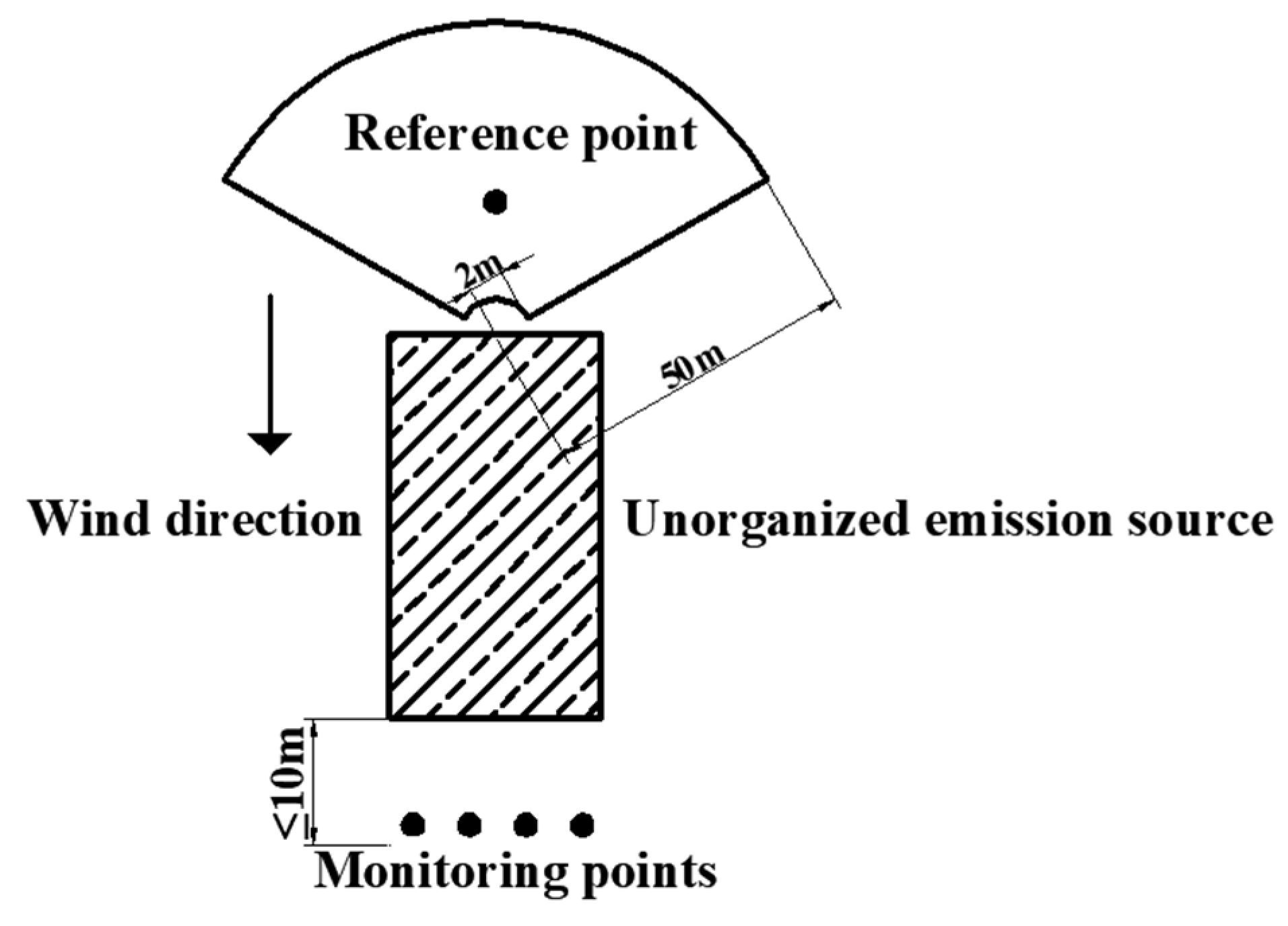
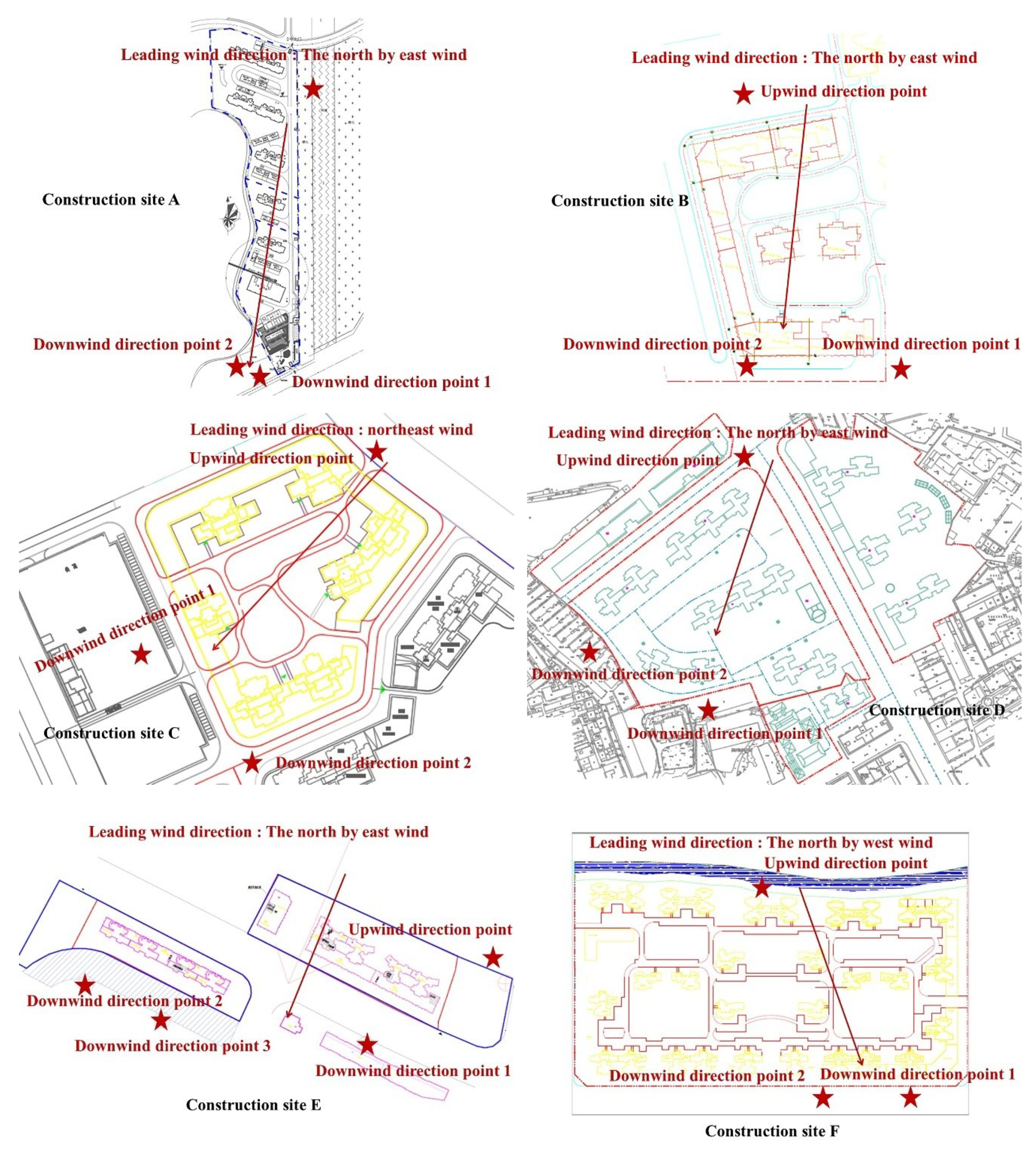
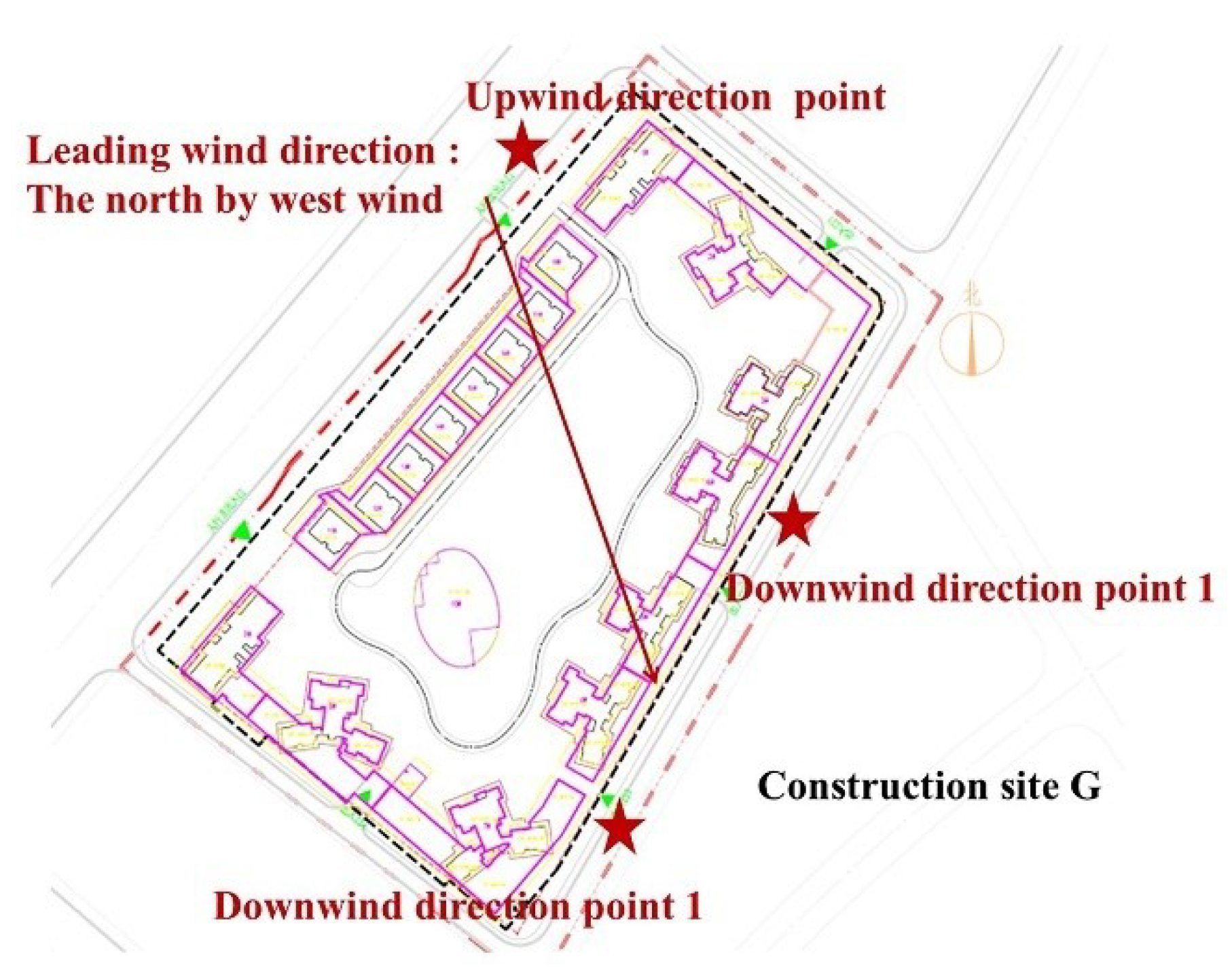
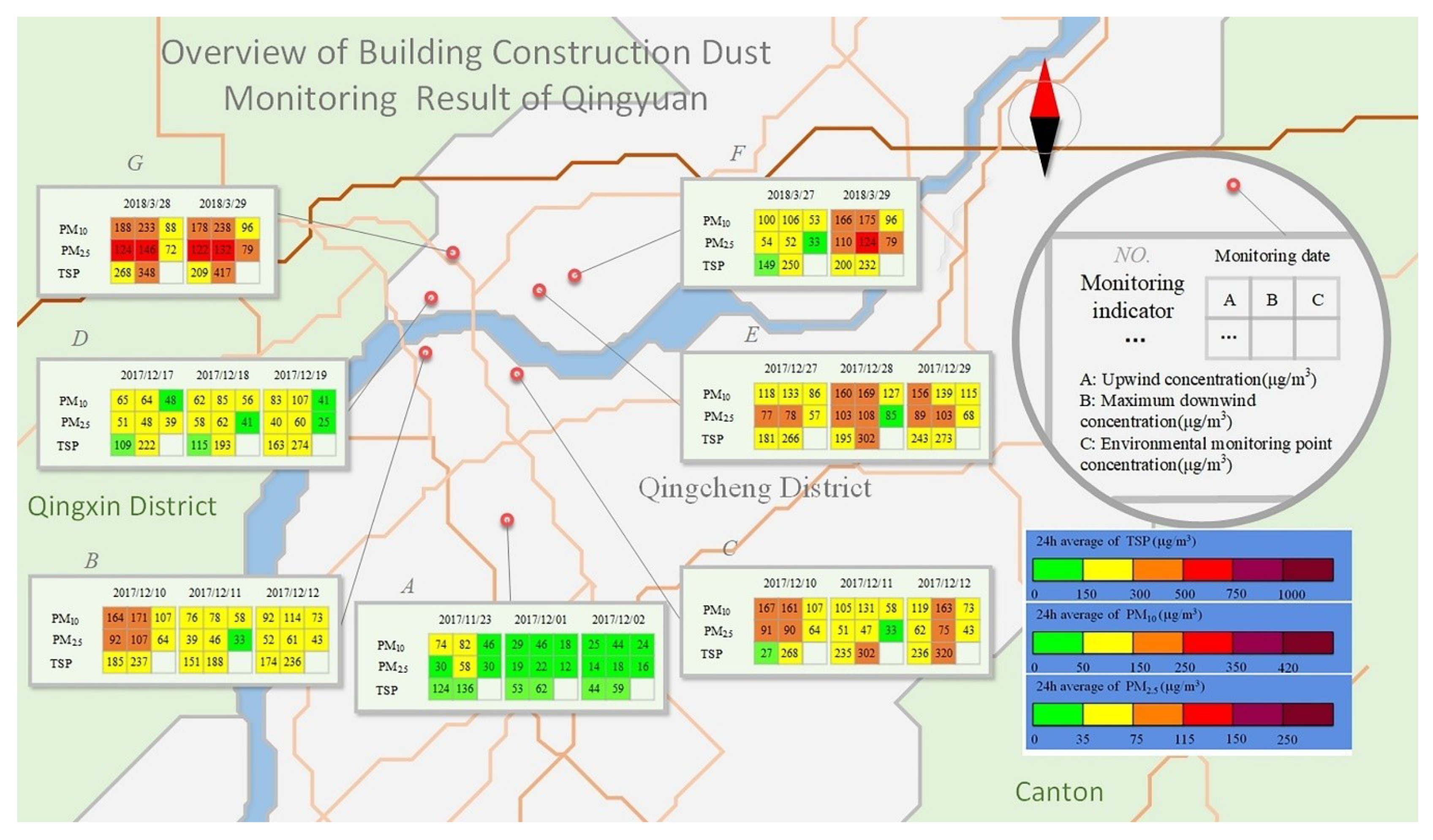
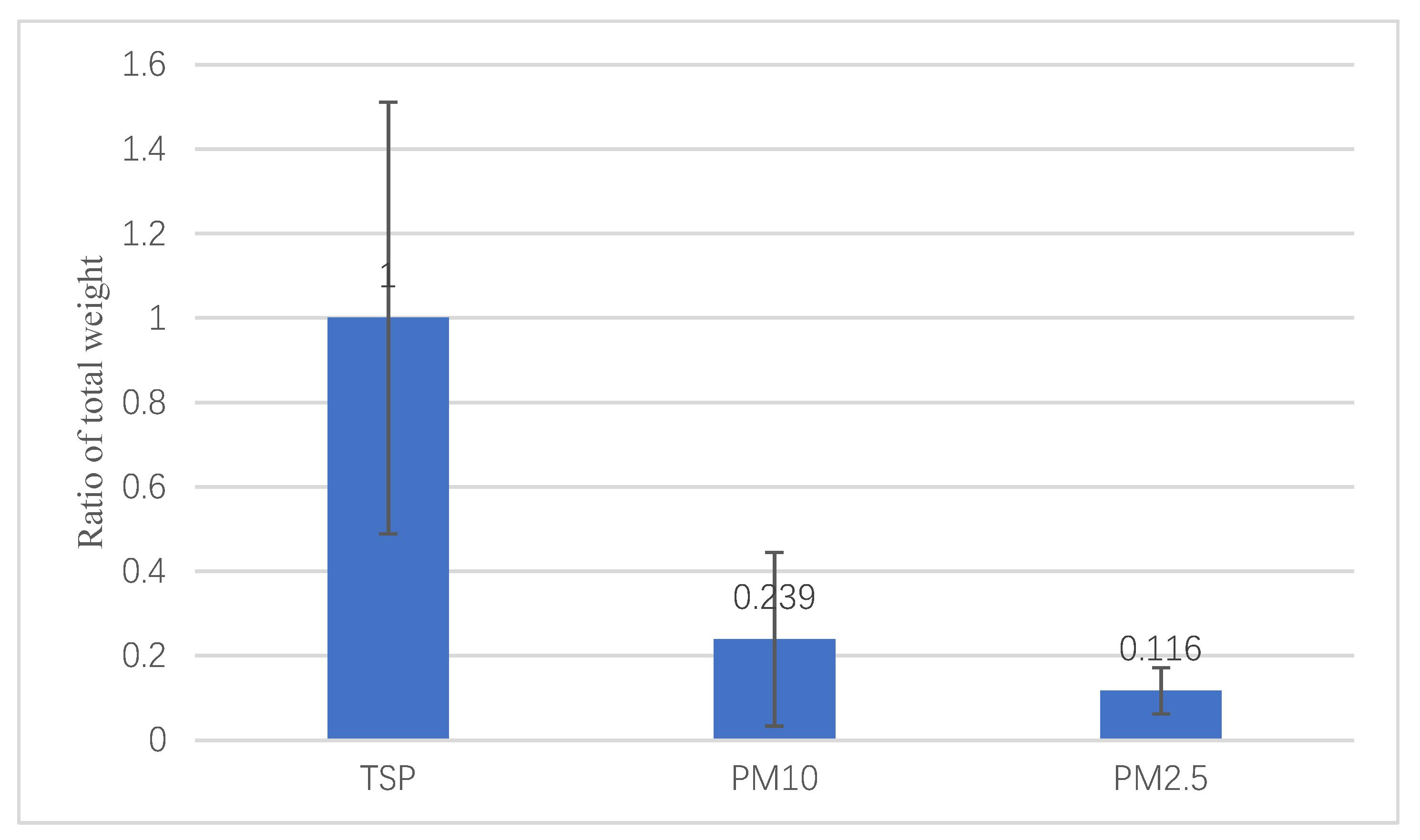
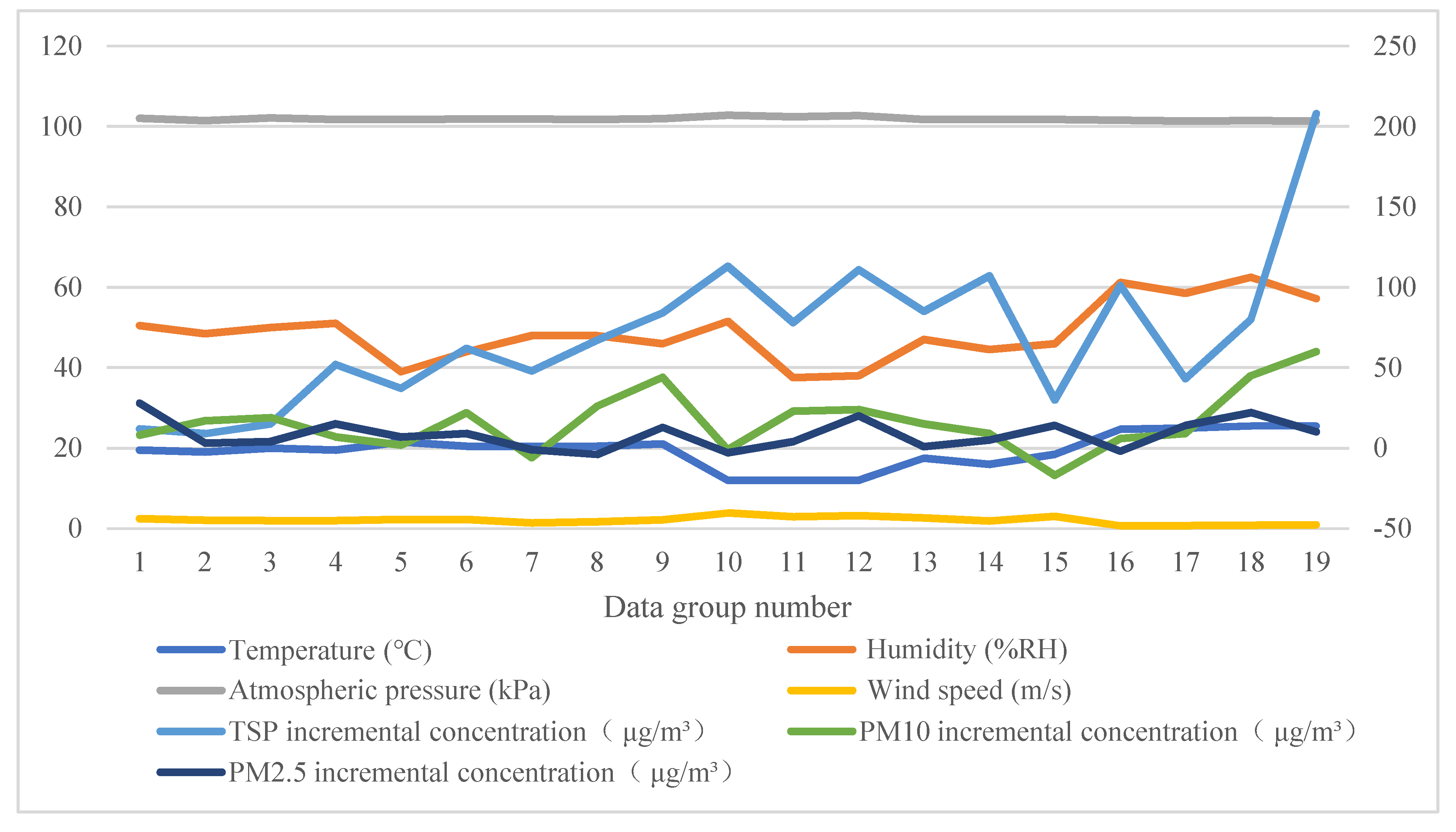
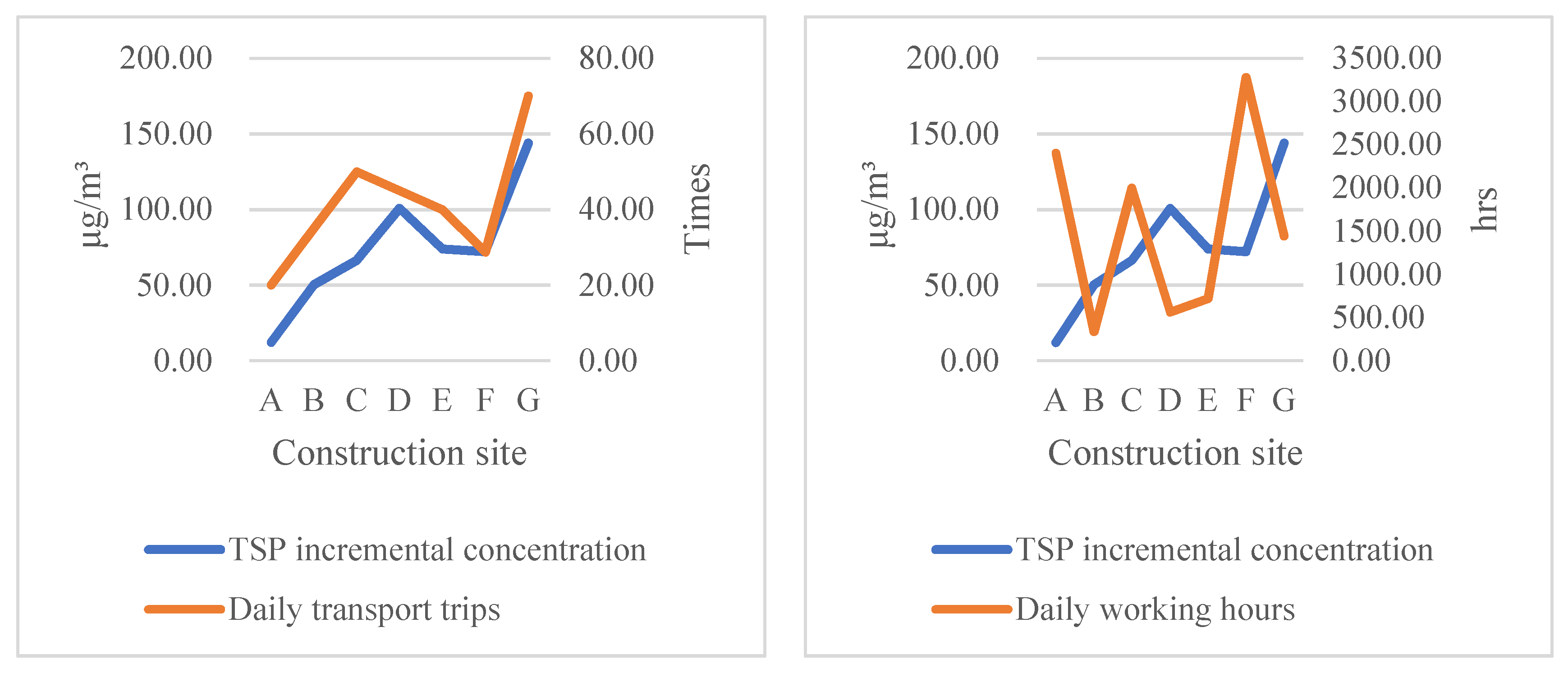
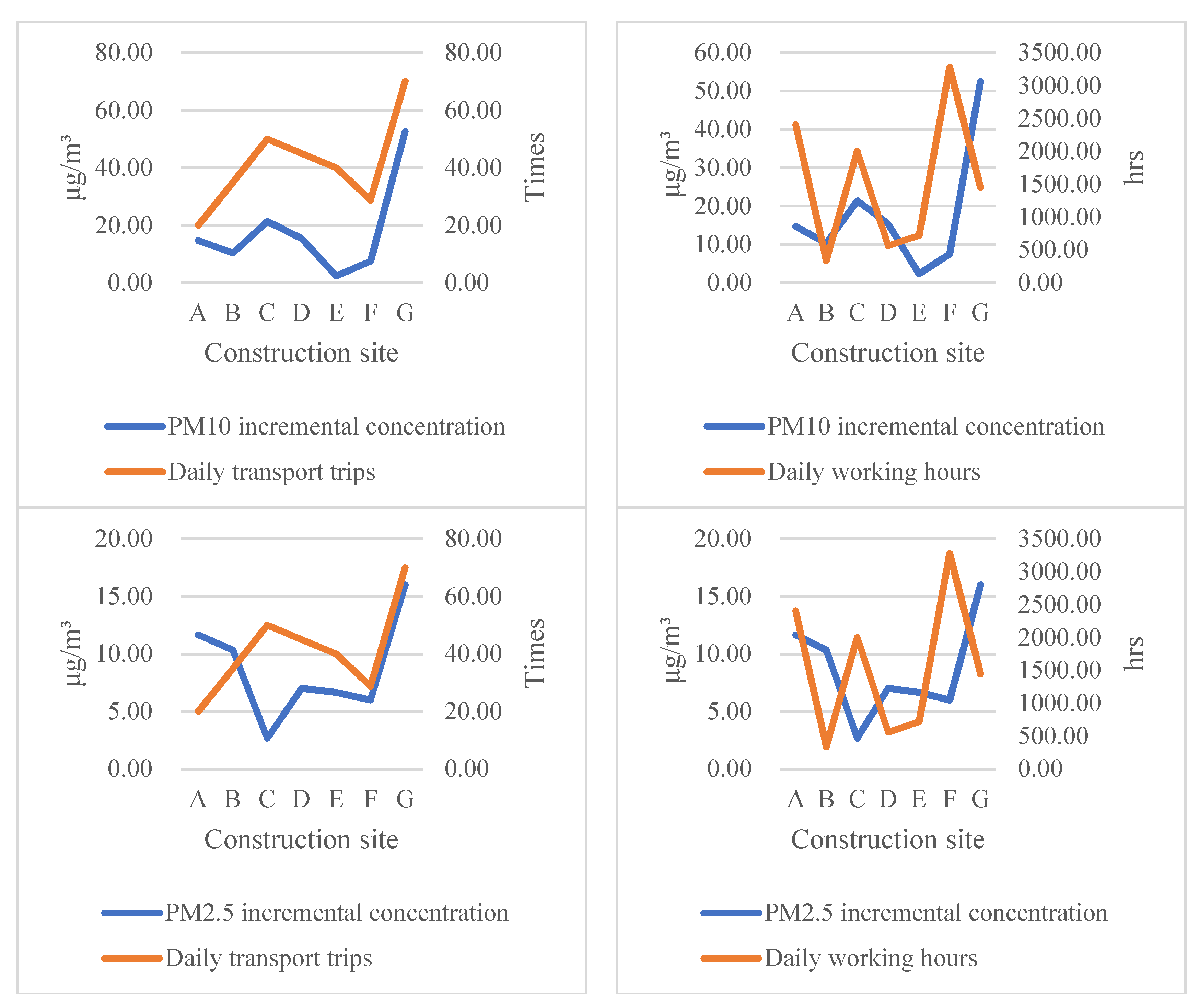
| Monitoring Indicator | Ambient Air Functional Area Level | Unit | Concentration Limit | Reference |
|---|---|---|---|---|
| TSP | level II | μg/m3 | 300 | [43] |
| PM10 | level II | μg/m3 | 150 | |
| PM2.5 | level II | μg/m3 | 75 |
| NO. | ProjectIndex | Number of Stores (Aboveground/Underground) | Structure Type | Usage | Construction site Area (m2) | Construction Stage * |
|---|---|---|---|---|---|---|
| 1 | A | 18/1 | Frame-shear wall structure | Apartment | 33,500 m2 | Foundation and main engineering |
| 2 | B | 22/2 | Frame-shear wall structure | Commercial and residential | 7087.63 m2 | Foundation, main and decoration engineering |
| 3 | C | 31/2 | Frame-shear wall structure | Residential | 35,511.07 m2 | Main engineering |
| 4 | D | 31/2 | Frame-shear wall structure | Commercial and residential | 32,504.66 m2 | Decoration engineering |
| 5 | E | 31(32)/2 | Frame-shear wall structure | Commercial and residential | 39,823.07 m2 | Foundation, main and decoration engineering |
| 6 | F | 32/1 | Frame-shear wall structure | Residential | 51,589.97 m2 | Main engineering |
| 7 | G | 32/1 | Frame-shear wall structure | Commercial and residential | 42,362.92 m2 | Foundation and decoration engineering |
| Indicators | Total Number of Monitoring Points | The Number of Monitoring Points Not Up to Local Standard | Over-Standard Rate | Up-to-Standard Rate |
|---|---|---|---|---|
| TSP | 60 | 6 | 10.00% | 90.00% |
| PM10 | 60 | 19 | 31.67% | 68.33% |
| PM2.5 | 60 | 25 | 41.67% | 58.33% |
| Kolmogorov-Smirnov a | |||
|---|---|---|---|
| Statistic | df (Degree of Freedom) | Significance | |
| Upwind direction TSP concentration | 0.086 | 19 | 0.200 * |
| Downwind direction TSP concentration | 0.144 | 19 | 0.200 * |
| Upwind direction PM10 concentration | 0.176 | 19 | 0.126 |
| Downwind direction PM10 concentration | 0.098 | 19 | 0.200 * |
| Upwind direction PM2.5 concentration | 0.141 | 19 | 0.200 * |
| Downwind direction PM2.5 concentration | 0.173 | 19 | 0.137 |
| t | df | Significance (Two-Tailed) | ||
|---|---|---|---|---|
| Pair 1 | Upwind direction TSP concentration-Downwind direction TSP concentration | −6.540 | 18 | 0.000 |
| Pair 2 | Upwind direction PM10 concentration-Downwind direction PM10 concentration | −3.851 | 18 | 0.001 |
| Pair 3 | Upwind direction PM2.5 concentration-Downwind direction PM2.5 concentration | −4.064 | 18 | 0.001 |
| N | Correlation | Significance | ||
|---|---|---|---|---|
| Pair 1 | Upwind direction TSP concentration & Downwind direction TSP concentration | 19 | 0.866 | 0.000 |
| Pair 2 | Upwind direction PM10 concentration & Downwind direction PM10 concentration | 19 | 0.945 | 0.000 |
| Pair 3 | Upwind direction PM2.5 concentration & Downwind direction PM2.5 concentration | 19 | 0.970 | 0.000 |
| Construction Site | Monitoring Date | TSP Incremental Concentration | PM10 Incremental Concentration | PM2.5 Incremental Concentration |
|---|---|---|---|---|
| μg/m3 | ||||
| A | 23 November 2017 | 12 | 8 | 28 |
| 1 December 2017 | 9 | 17 | 3 | |
| 2 December 2017 | 15 | 19 | 4 | |
| B | 10 December 2017 | 52 | 7 | 15 |
| 11 December 2017 | 37 | 2 | 7 | |
| 12 December 2017 | 62 | 22 | 9 | |
| C | 10 December 2017 | 48 | −6 | −1 |
| 11 December 2017 | 67 | 26 | −4 | |
| 12 December 2017 | 84 | 44 | 13 | |
| D | 17 December 2017 | 113 | −1 | −3 |
| 18 December 2017 | 78 | 23 | 4 | |
| 19 December 2017 | 111 | 24 | 20 | |
| E | 27 December 2017 | 85 | 15 | 1 |
| 28 December 2017 | 107 | 9 | 5 | |
| 29 December 2017 | 30 | −17 | 14 | |
| F | 27 March 2018 | 101 | 6 | −2 |
| 29 March 2018 | 43 | 9 | 14 | |
| G | 28 March 2018 | 80 | 45 | 22 |
| 29 March 2018 | 208 | 60 | 10 | |
| Incremental concentration average | 70.63 | 16.42 | 8.37 | |
| Relative incremental concentration | 42.24% | 19.76% | 16.27% | |
| Standard deviation | 47.08 | 18.59 | 8.98 | |
| Environmental Monitoring Point PM10 Concentration | ||
|---|---|---|
| PM10 incremental concentration | Pearson Correlation | −0.107 |
| significance (two-tailed) | 0.664 | |
| N | 19 | |
| Environmental monitoring point PM2.5 concentration | ||
| PM2.5 incremental concentration | Pearson Correlation | 0.176 |
| significance (two-tailed) | 0.470 | |
| N | 19 | |
| Temperature | Humidity | Atmospheric Pressure | Wind Speed | ||
|---|---|---|---|---|---|
| TSP incremental concentration | Pearson Correlation | 0.004 | 0.178 | 0.054 | −0.105 |
| Significance (two-tailed) | 0.986 | 0.465 | 0.827 | 0.669 | |
| N | 19 | 19 | 19 | 19 | |
| PM10 incremental concentration | Pearson Correlation | 0.303 | 0.207 | −0.191 | −0.323 |
| Significance (two-tailed) | 0.207 | 0.395 | 0.433 | 0.177 | |
| N | 19 | 19 | 19 | 19 | |
| PM2.5 incremental concentration | Pearson Correlation | 0.151 | 0.078 | −0.046 | −0.008 |
| Significance (two-tailed) | 0.536 | 0.750 | 0.853 | 0.973 | |
| N | 19 | 19 | 19 | 19 | |
| Daily Working Hours | Daily Transport Trips | ||
|---|---|---|---|
| TSP incremental concentration | Pearson Correlation | 0.136 | 0.890 ** |
| Significance (two-tailed) | 0.771 | 0.007 | |
| N | 7 | 7 | |
| PM10 incremental concentration | Pearson Correlation | 0.065 | 0.801 * |
| Significance (two-tailed) | 0.890 | 0.030 | |
| N | 7 | 7 | |
| PM2.5 incremental concentration | Pearson Correlation | −0.333 | 0.268 |
| Significance (two-tailed) | 0.465 | 0.562 | |
| N | 7 | 7 | |
© 2019 by the authors. Licensee MDPI, Basel, Switzerland. This article is an open access article distributed under the terms and conditions of the Creative Commons Attribution (CC BY) license (http://creativecommons.org/licenses/by/4.0/).
Share and Cite
Yan, H.; Ding, G.; Li, H.; Wang, Y.; Zhang, L.; Shen, Q.; Feng, K. Field Evaluation of the Dust Impacts from Construction Sites on Surrounding Areas: A City Case Study in China. Sustainability 2019, 11, 1906. https://doi.org/10.3390/su11071906
Yan H, Ding G, Li H, Wang Y, Zhang L, Shen Q, Feng K. Field Evaluation of the Dust Impacts from Construction Sites on Surrounding Areas: A City Case Study in China. Sustainability. 2019; 11(7):1906. https://doi.org/10.3390/su11071906
Chicago/Turabian StyleYan, Hui, Guoliang Ding, Hongyang Li, Yousong Wang, Lei Zhang, Qiping Shen, and Kailun Feng. 2019. "Field Evaluation of the Dust Impacts from Construction Sites on Surrounding Areas: A City Case Study in China" Sustainability 11, no. 7: 1906. https://doi.org/10.3390/su11071906
APA StyleYan, H., Ding, G., Li, H., Wang, Y., Zhang, L., Shen, Q., & Feng, K. (2019). Field Evaluation of the Dust Impacts from Construction Sites on Surrounding Areas: A City Case Study in China. Sustainability, 11(7), 1906. https://doi.org/10.3390/su11071906







